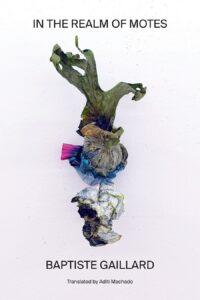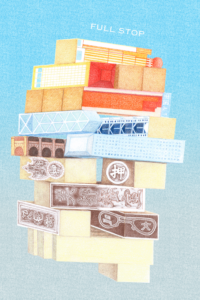
[Roof Books; 2025]
Tr. from the French by Aditi Machado
In Baptiste Gaillard’s new book, addition and subtraction are the circulatory principles of matter, the chroniclers of entanglements. Particles rest or are in motion. They float through water. They mix. They agglutinate in churning pools. Matter is the spell of the gelatinous, of oozing trapped liquids that usher otherworldly colors, of electricity encountering mud, and plants sculpting ruins. “Things go on agglomerating” through processes of incorporation and differentiation, through stark contrasts and periods “during which everything remains identical.” In the Realm of Motes, a collection of prose poems dazzlingly translated by Aditi Machado, catalogues the molecular level of materials. Originally from Switzerland, writer, artist, and cultural mediator Baptiste Gaillard has authored six books, including Un domaine des corpuscules, which won the Swiss Literature Prize in 2018 and now appears for the first time in English. This is Machado’s second book of translation; the first was Farid Tali’s Prosopopoeia. According to Roof Books, Gaillard’s work “explores the thresholds of the sensible and tells of materials and transient states, like the condensation on a window that disappears as soon as it is imprinted.” Machado, the author of three stunning poetry books published by Nightboat, proves an ideal translator for Gaillard. In Machado’s rendition of these poems, correspondences enfold between the depersonalized world of substances in Gaillard and Machado’s deft ability to render observation lyrically alert, a trait of her own poetry. The translation is superb—precise and moving.
In Gaillard’s collection, organic and human-made things tempt the same spaces in exuberant coexistence. The book begins with water:
When it rains, the frontiers of water begin to shift. The
rain makes no impact on the ocean into which nothing
no longer sinks.
Water propels the decomposition of materials, blending and transforming them into assemblages of decay that meet and join other assemblages. Water equally drags plant life and plastics and in its dark environments webs of entanglement come to fruition. Water appears in all states always moving in its endless task of decomposition. Even when it appears still and unmoving, water keeps laboring:
Frost grows on ferns, condensates congealing in
clumps. Water gets thicker and thicker, works in
slow motion. Its flow is becoming a solid object, an
entrail at once smooth and irregular, stretched all
the way across. For a brief moment, when the
change is not yet complete, different states of
matter intermix. Then, stones and other materials
that used to protrude now simply come out from
under the cover of ice. Textural variations, for
example in the cliff.
While we associate water with life, the processes that water unleashes are corrosive and intestinal. Water appears as an enormous stomach that consumes and feeds off every possible substance, from garbage to organic matter. These poems breathe matter deposited by way of erosion and wind, tossed and churned, but also the byproducts of the massive machinery of human waste. Water is an abdomen and a mouth that lays waste to all particles finding their way into it, joining the small and large alike.
Human witnesses are nowhere in this book. Even the urban landscape and its sprawl of buildings are presented through chemical processes. People appear only through the material traces they leave behind:
Plastic toys leave colorful stains on the
ground that structure the rising disorder of the
wastelands.
Dust settles in cans of fresh paint, ruining it.
The sun shines indifference onto buildings; housing projects totter toward decay. Light shines and shows what is extant in its force, that is, an imperceptible and continuous movement toward dissolution, the entropic forces of the universe. The irregular shape, the creaking house, the warped wood, and then the asphalt, or rather “Zones of neglect” are buzzing with the work of organisms and the incessant flow of change.
Gaillard’s characters are chemical reactions, states of decomposition, accumulation, and withdrawal. You may think that the impersonality of these poems, the absence of personal pronouns and of human affects and volition, would preclude the work of empathy. Yet, this apparently objective record of material transformations streams the sad vulnerability of the world. Gaillard suggests how humans belong to matter and are themselves reflections and productions of similar processes. We have come from motes to inhabit a world of motes and to motes we will return.
Through the focus on the small, the cosmic entanglement of everything emerges. Processes of addition and subtraction will continue through time, and through this mysterious propagation, matter becomes vibrant. Animation seemingly contains an engine’s spark, a beating heart, the tremor of creativity. Everything flows, continues, spills. The world of matter is ever streaming in motions of pure liquidity:
The water does not break, but like any formless,
malleable thing it flows in all directions, adapting to
obstacles upon collision and paradoxically endowing
them with shape, sometimes just for a little while
before clouding up again, other times for much longer.
Chunks of melting ice forge a union of waters; only the
largest pieces remain separate for a time.
Cement and plants co-exist in a perplexing and vexing mesh. Everything settles by necessity, as if, environmentally speaking, there were no distinction between the fabricated and the organic. Materials seem to exude an awareness of their own existence; they perform an appearing that marks both an inevitable separation and a future mingling. The alien particle arrives to disturb surfaces and slowly erases stratification and difference:
Plastics remain separate for longer, like floating
curds impervious to the movements happening
around them, remnants isolated from the
ensemble.
Polystyrene gets ripped up into moss-like clumpsand spreads out in the form of electrostatic shreds
that attract lighter objects to themselves or else
get stuck to something bigger.
A microcosmos appears through the close examination of the infinitely small. By getting close, we get further into the sampling of processes that shape the scope of time and space at a macro scale of cosmic magnitude and of a quantity we cannot fathom.
Gaillard’s book is “a catalog of that which can move” and of that which stays inert. For, “In the end, the earth’s a massive pile of slop,” a pile that works through addition and subtraction, disintegrating and then meshing organic materials with the human-made. Substances tempt the same spaces, sputtering, merging, drifting. And finally, there is the silence of clouds and the stillness that drifting—seen cosmically from within the small—at last entails:
Large clouds move across the sky and vanish into the
horizon having made no impact at all.
In the Realm of Motes is a brilliant book of observation where time is a moving fossil, the experience of matter is a planet-wide mastication, a circulation in sinuous paths. The unity we perceive in our bodies is also a stage, a fumbling “slop.” To understand the object world in its entropy is to perceive also a reflection of the human in the joint scale of a togetherness.
Isabel Sobral Campos is the author of The Optogram of the Mind is a Carnation, selected for the Futurepoem 2023 Other Futures Award, as well as two other full-length poetry books, several chapbooks, and a collaborative translation of Salette Tavares’s LEX ICON (Ugly Duckling Presse). Her poems have appeared in Fence, Boston Review, Black Sun Lit, the Brooklyn Rail, and elsewhere. She co-founded and edits Sputnik & Fizzle press.
This post may contain affiliate links.






